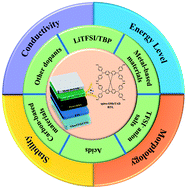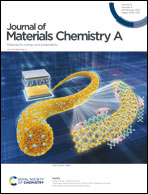Strategies of modifying spiro-OMeTAD materials for perovskite solar cells: a review
Abstract
Organic–inorganic hybrid perovskite solar cells (PSCs) have made unprecedented progress in the past ten years, the power conversion efficiency of which increased from 3.8% in 2009 to 25.5% in 2020. The choice of hole transport layers (HTLs) is a key factor for achieving efficient and stable PSCs. Recently, 2,2′,7,7′-tetrakis-(N,N-di-4-methoxyphenylamino)-9,9′-spirobifluorene (spiro-OMeTAD) has been proven to be the most suitable small molecule HTL material in n–i–p PSCs. However, the conductivity and hole mobility of spiro-OMeTAD are dependent on the dopants. Bis(trifluoromethane)sulfonamide lithium salt (LiTFSI) and 4-tert-butylpyridine (TBP) have become the standard HTL dopants to improve the charge transport properties of n–i–p PSCs. Both of these two dopants are effective but have a negative impact on the device stability (induced by ion migration, hygroscopicity, and corrosiveness). In response, lots of efforts have been devoted to the development of alternative and new dopants. In this review, the influence of different doping strategies and corresponding doping mechanisms on device performance and stability was mainly discussed. The stability issues of doped spiro-OMeTAD based PSCs were also described. Finally, we proposed some possible future research goals for dopants based on these existing results to obtain long-lasting and high-efficiency PSCs.

- This article is part of the themed collection: Journal of Materials Chemistry A Recent Review Articles


 Please wait while we load your content...
Please wait while we load your content...